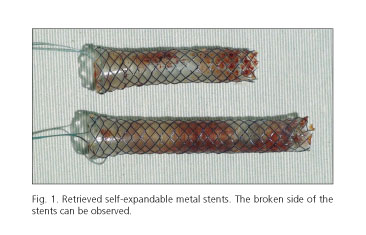My SciELO
Services on Demand
Journal
Article
Indicators
-
 Cited by SciELO
Cited by SciELO -
 Access statistics
Access statistics
Related links
-
 Cited by Google
Cited by Google -
 Similars in
SciELO
Similars in
SciELO -
 Similars in Google
Similars in Google
Share
Revista Española de Enfermedades Digestivas
Print version ISSN 1130-0108
Rev. esp. enferm. dig. vol.108 n.4 Madrid Apr. 2016
PICTURES IN DIGESTIVE PATHOLOGY
Successive breaks in biliary stents
Jesús Espinel1, Eugenia Pinedo2, Vanesa Ojeda3 and María Guerra del-Río4
Departments of 1 Digestive Diseases and 2 Radiodiagnosis. Hospital Universitario de León. León, Spain.
3 Department of Digestive Diseases. Hospital Universitario Dr. Negrín. Las Palmas de Gran Canaria, Spain.
4 Consultant Gastroenterologist. Burton Hospitals NHS foundation trust. Burton on Trent. United Kingdom
Case Report
A 64 year-old male, was diagnosed with obstructive jaundice due to a well-differentiated pancreatic neuroendocrine tumor with liver metastases. The patient underwent endoscopic placement of covered self-expanding biliary stent (10x60 mm, Hanaro) by ERCP. He was admitted with cholangitis one year later. The following ERCP revealed a fractured stent with loss of the distal end (duodenal) and partial migration of the remaining stent to the common bile duct. The fragmented stent was removed from the common bile duct and a new, similar one was inserted. Four months later the patient was admitted with cholangitis. A new ERCP was done and biliary stent was also fragmented. It was removed and an uncovered stent (Wallflex) was inserted.
Evolution: In spite of endoscopic treatment and alternative draining procedures (percutaneous biliary drainage [PBD]) the patient suffered successive episodes of colangitis. The figure 1 shows the removed fractured stents.
Discussion
The placement of self-expanding metallic stents in the treatment of nonsurgical neoplastic biliary obstruction provides prolonged palliation of symptoms with high efficiency and few complications. Fractures are a rare complication of metallic biliary stents. The cases described in the literature have mostly involved nitinol stents. The time taken for the break to appear varies (1-21 months). The cause is not clearly established. Different mechanisms can be identified:
1. A manufacturing fault: this possibility has been considered in cases where the break happens early on.
2. Metal corrosion: a mechanism possibly related to late breaks.
3. Metal fatigue/stress (nitinol): nitinol stents are characterized by a good radial strength and flexibility, with little shortening. These characteristics, together with the fact that the patient had a pancreatic neuroendocrine tumour -characterized by its great rigidity- may have conditioned the successive breaks.
References
1. Born P, Rösch T, Classen M. Spontaneous rupture of a biliary metal stent. Endoscopy 1998;30:S78. DOI: 10.1055/s-2007-1001377. [ Links ]
2. Sriram PV, Ramakrishnan A, Rao GV, et al. Spontaneous fracture of a biliary self-expanding metal stent. Endoscopy 2004;36:1035-6. DOI: 10.1055/s-2004-825969. [ Links ]
3. Rasmussen IC, Dahlstrand U, Sandblom G, et al. Fractures of self-expanding metallic stents in periampullary malignant biliary obstruction. Acta Radiol 2009;50:730-7. DOI: 10.1080/02841850903039763. [ Links ]
4. Kawakubo K, Isayama H, Tsujino T, et al. Endoscopic removal of a spontaneously fractured biliary uncovered self-expandable metal stent. Dig Endosc 2012;24:182-4. DOI: 10.1111/j.1443-1661.2011.01189.x. [ Links ]














